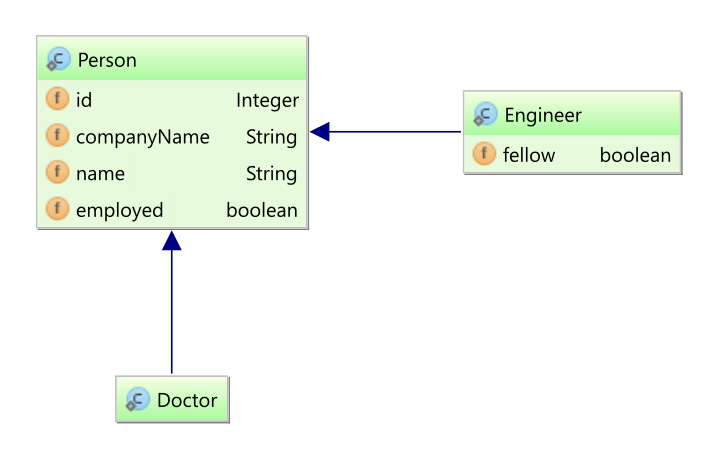本文介绍了HHH-11262 JIRA问题,现在允许批量ID策略在无法创建临时表的情况下也能工作。
类图
假设我们有以下实体

Person实体是这个实体继承模型的基础类,映射如下
@Entity(name = "Person")
@Inheritance(
strategy = InheritanceType.JOINED
)
public class Person
implements Serializable {
@Id
private Integer id;
@Id
private String companyName;
private String name;
private boolean employed;
//Getters and setters omitted for brevity
@Override
public boolean equals(Object o) {
if ( this == o ) {
return true;
}
if ( !( o instanceof Person ) ) {
return false;
}
Person person = (Person) o;
return Objects.equals(
getId(),
person.getId()
) &&
Objects.equals(
getCompanyName(),
person.getCompanyName()
);
}
@Override
public int hashCode() {
return Objects.hash(
getId(), getCompanyName()
);
}
}Doctor和Engineer实体类都扩展了Person基础类
@Entity(name = "Doctor")
public class Doctor
extends Person {
}
@Entity(name = "Engineer")
public class Engineer
extends Person {
private boolean fellow;
//Getters and setters omitted for brevity
}继承树批量处理
现在,当你尝试执行一个批量实体查询时
int updateCount = session.createQuery(
"delete from Person where employed = :employed" )
.setParameter( "employed", false )
.executeUpdate();Hibernate执行以下语句
create temporary table
HT_Person
(
id int4 not null,
companyName varchar(255) not null
)
insert
into
HT_Person
select
p.id as id,
p.companyName as companyName
from
Person p
where
p.employed = ?
delete
from
Engineer
where
(
id, companyName
) IN (
select
id,
companyName
from
HT_Person
)
delete
from
Doctor
where
(
id, companyName
) IN (
select
id,
companyName
from
HT_Person
)
delete
from
Person
where
(
id, companyName
) IN (
select
id,
companyName
from
HT_Person
)HT_Person是Hibernate创建的一个临时表,用于存储所有要由批量ID操作更新或删除的实体标识符。该临时表可以是全局的或本地的,具体取决于底层数据库的能力。
如果不能创建临时表怎么办?
如HHH-11262问题所述,在某些情况下,应用程序开发人员无法使用临时表,因为数据库用户没有这个权限。
在这种情况下,我们定义了几个选项,您可以根据自己的数据库能力进行选择
-
InlineIdsInClauseBulkIdStrategy -
InlineIdsSubSelectValueListBulkIdStrategy -
InlineIdsOrClauseBulkIdStrategy -
CteValuesListBulkIdStrategy
InlineIdsInClauseBulkIdStrategy
要使用此策略,您需要配置以下配置属性
<property name="hibernate.hql.bulk_id_strategy"
value="org.hibernate.hql.spi.id.inline.InlineIdsInClauseBulkIdStrategy"
/>现在,当运行之前的测试用例时,Hibernate生成了以下SQL语句
select
p.id as id,
p.companyName as companyName
from
Person p
where
p.employed = ?
delete
from
Engineer
where
( id, companyName )
in (
( 1,'Red Hat USA' ),
( 3,'Red Hat USA' ),
( 1,'Red Hat Europe' ),
( 3,'Red Hat Europe' )
)
delete
from
Doctor
where
( id, companyName )
in (
( 1,'Red Hat USA' ),
( 3,'Red Hat USA' ),
( 1,'Red Hat Europe' ),
( 3,'Red Hat Europe' )
)
delete
from
Person
where
( id, companyName )
in (
( 1,'Red Hat USA' ),
( 3,'Red Hat USA' ),
( 1,'Red Hat Europe' ),
( 3,'Red Hat Europe' )
)因此,首先选择实体标识符,然后用于每个特定的更新或删除语句。
|
IN子句行值表达式已经由Oracle、PostgreSQL支持很长时间了,现在MySQL 5.7也支持。然而,SQL Server 2014不支持此语法,因此您必须使用不同的策略。 |
InlineIdsSubSelectValueListBulkIdStrategy
要使用此策略,您需要配置以下配置属性
<property name="hibernate.hql.bulk_id_strategy"
value="org.hibernate.hql.spi.id.inline.InlineIdsSubSelectValueListBulkIdStrategy"
/>现在,当运行之前的测试用例时,Hibernate生成了以下SQL语句
select
p.id as id,
p.companyName as companyName
from
Person p
where
p.employed = ?
delete
from
Engineer
where
( id, companyName ) in (
select
id,
companyName
from (
values
( 1,'Red Hat USA' ),
( 3,'Red Hat USA' ),
( 1,'Red Hat Europe' ),
( 3,'Red Hat Europe' )
) as HT
(id, companyName)
)
delete
from
Doctor
where
( id, companyName ) in (
select
id,
companyName
from (
values
( 1,'Red Hat USA' ),
( 3,'Red Hat USA' ),
( 1,'Red Hat Europe' ),
( 3,'Red Hat Europe' )
) as HT
(id, companyName)
)
delete
from
Person
where
( id, companyName ) in (
select
id,
companyName
from (
values
( 1,'Red Hat USA' ),
( 3,'Red Hat USA' ),
( 1,'Red Hat Europe' ),
( 3,'Red Hat Europe' )
) as HT
(id, companyName)
)|
底层数据库必须支持VALUES列表子句,例如PostgreSQL或SQL Server 2008。然而,此策略需要IN子句行值表达式来表示复合标识符,因此您只能使用PostgreSQL。 |
InlineIdsOrClauseBulkIdStrategy
要使用此策略,您需要配置以下配置属性
<property name="hibernate.hql.bulk_id_strategy"
value="org.hibernate.hql.spi.id.inline.InlineIdsOrClauseBulkIdStrategy"
/>现在,当运行之前的测试用例时,Hibernate生成了以下SQL语句
select
p.id as id,
p.companyName as companyName
from
Person p
where
p.employed = ?
delete
from
Engineer
where
( id = 1 and companyName = 'Red Hat USA' )
or ( id = 3 and companyName = 'Red Hat USA' )
or ( id = 1 and companyName = 'Red Hat Europe' )
or ( id = 3 and companyName = 'Red Hat Europe' )
delete
from
Doctor
where
( id = 1 and companyName = 'Red Hat USA' )
or ( id = 3 and companyName = 'Red Hat USA' )
or ( id = 1 and companyName = 'Red Hat Europe' )
or ( id = 3 and companyName = 'Red Hat Europe' )
delete
from
Person
where
( id = 1 and companyName = 'Red Hat USA' )
or ( id = 3 and companyName = 'Red Hat USA' )
or ( id = 1 and companyName = 'Red Hat Europe' )
or ( id = 3 and companyName = 'Red Hat Europe' )|
此策略的优点是所有主要的关系数据库系统都支持它(例如Oracle、SQL Server、MySQL和PostgreSQL)。 |
CteValuesListBulkIdStrategy
要使用此策略,您需要配置以下配置属性
<property name="hibernate.hql.bulk_id_strategy"
value="org.hibernate.hql.spi.id.inline.CteValuesListBulkIdStrategy"
/>现在,当运行之前的测试用例时,Hibernate生成了以下SQL语句
select
p.id as id,
p.companyName as companyName
from
Person p
where
p.employed = ?
with HT_Person (id,companyName ) as (
select id, companyName
from (
values
(?, ?),
(?, ?),
(?, ?),
(?, ?)
) as HT (id, companyName) )
delete
from
Engineer
where
( id, companyName ) in (
select
id, companyName
from
HT_Person
)
with HT_Person (id,companyName ) as (
select id, companyName
from (
values
(?, ?),
(?, ?),
(?, ?),
(?, ?)
) as HT (id, companyName) )
delete
from
Doctor
where
( id, companyName ) in (
select
id, companyName
from
HT_Person
)
with HT_Person (id,companyName ) as (
select id, companyName
from (
values
(?, ?),
(?, ?),
(?, ?),
(?, ?)
) as HT (id, companyName) )
delete
from
Person
where
( id, companyName ) in (
select
id, companyName
from
HT_Person
)|
底层数据库必须支持CTE(公共表表达式),这些表达式可以从非查询语句中引用,例如从9.1版本的PostgreSQL或从2005版本的SQL Server开始。底层数据库还必须支持VALUES列表子句,例如PostgreSQL或SQL Server 2008。 然而,此策略需要IN子句行值表达式来表示复合标识符,因此您只能使用PostgreSQL。 |
结论
如果可以使用临时表,那么这可能是最好的选择。然而,如果不允许创建临时表,就必须选择这些四种策略中的一种,使其与底层数据库兼容。在做出决定之前,应该对它们在当前负载下的表现进行基准测试。例如,CTE是PostgreSQL中的优化围栏,因此在做出决定之前请确保进行测量。
如果您使用Oracle或MySQL 5.7,可以选择InlineIdsOrClauseBulkIdStrategy或InlineIdsInClauseBulkIdStrategy。对于MySQL的旧版本,则只能使用InlineIdsOrClauseBulkIdStrategy。
如果您使用SQL Server,那么InlineIdsOrClauseBulkIdStrategy是您唯一的选择。
如果您使用PostgreSQL,那么您可以选择这四种策略中的任何一种。

